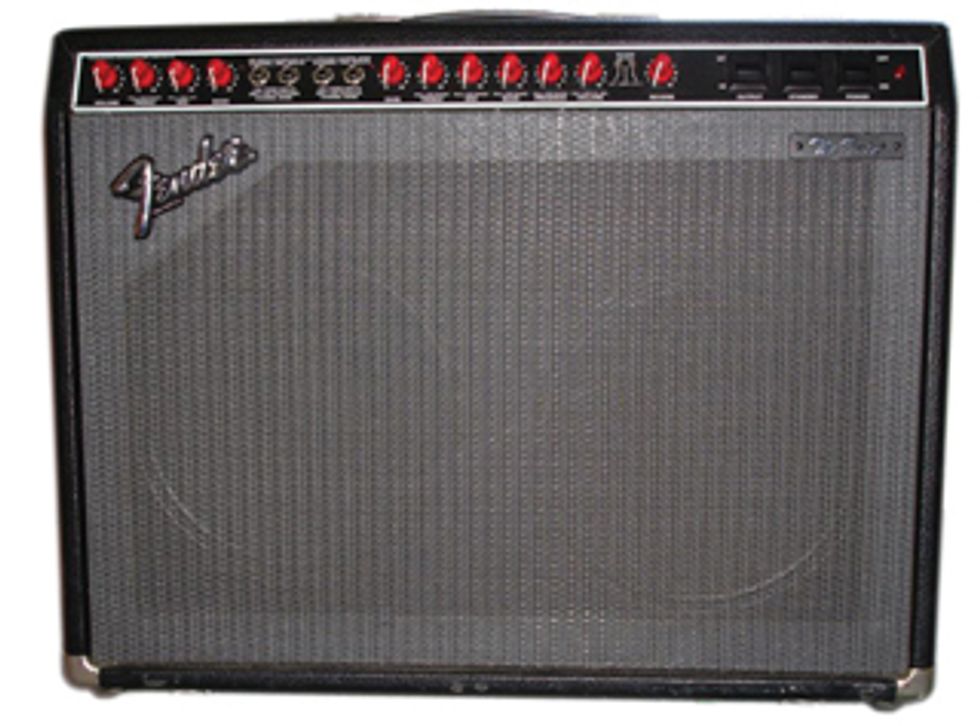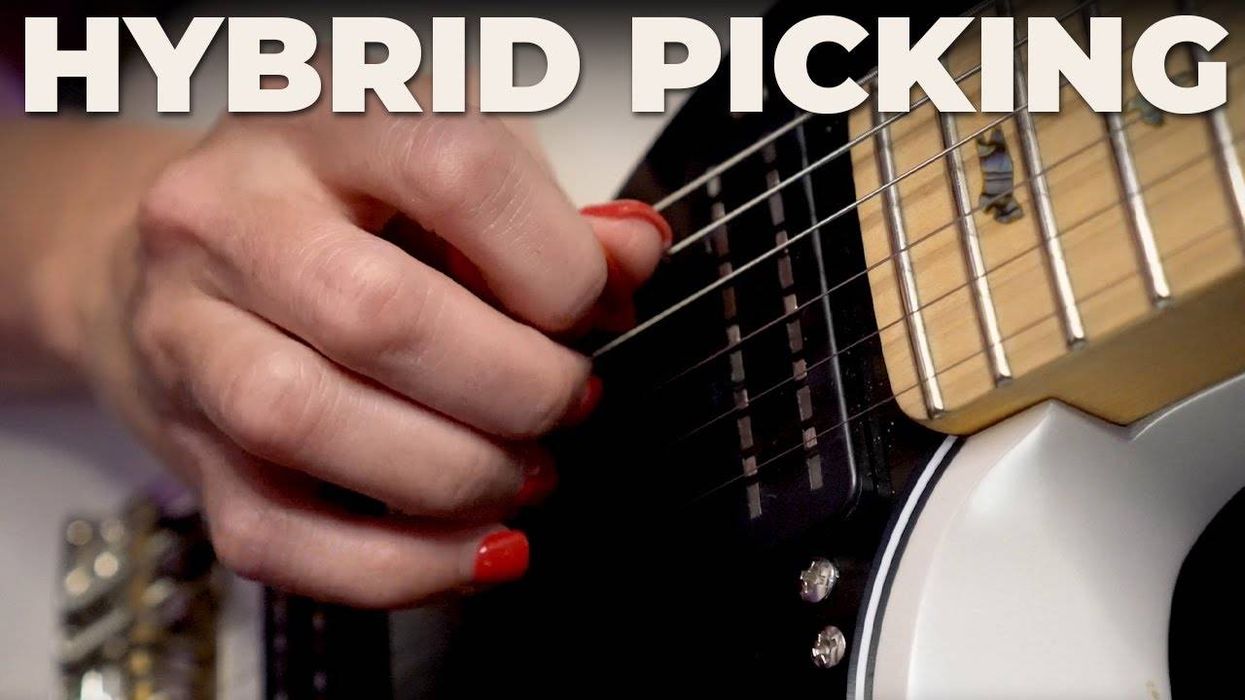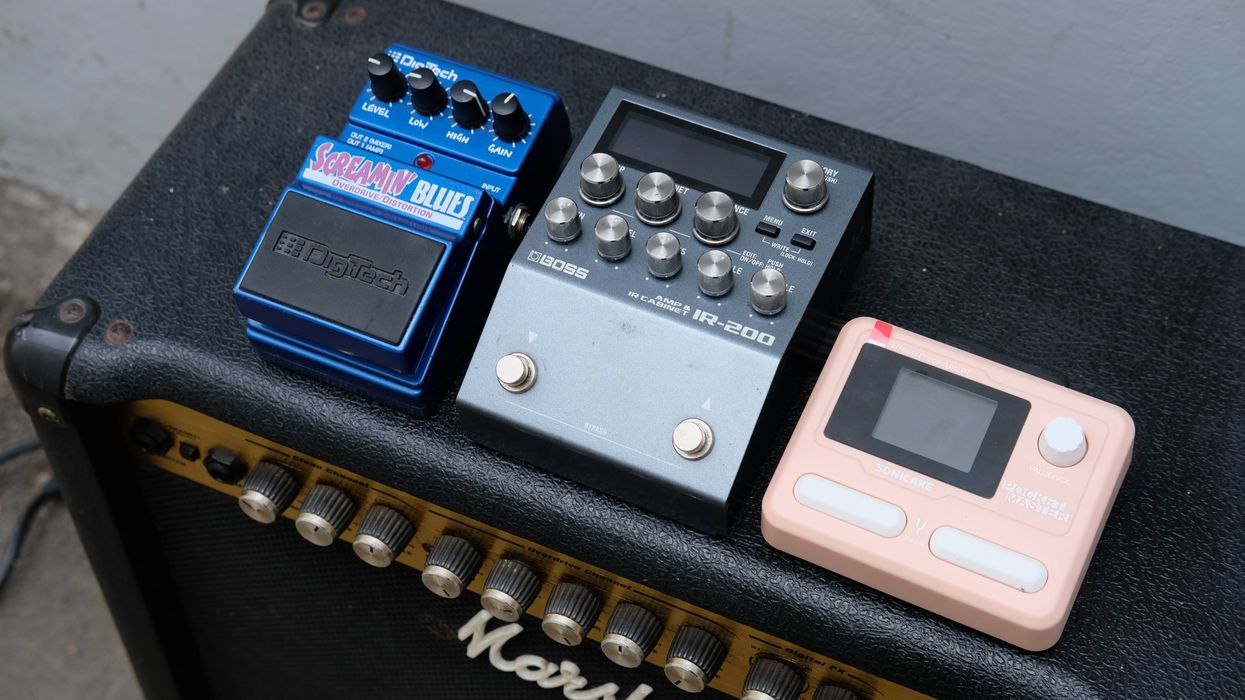
Found in backlines around the globe: Fender’s burly 100-watt, red-knob The Twin 2x12 combo. Photo courtesy of ampwares.com
Hi Jeff,
I have a couple of Fender The Twin
amps: a red-knob version (from 1988,
I think) and a black knob 1992 model.
I’m trying to improve the second channel
of these amps. The gain channel
seems to be very loose and grainy with
not much bottom end. I’ve tried every
combination of preamp tubes I can
think of with no success. I’m hoping
for a dirty, Eric Johnson-inspired
rhythm tone. From what I understand,
in his multi-amp rig he uses 6L6 output
tubes for his dirty rhythm tone.
I’m hoping that because my amp
contains 6L6 power tubes, I’ll be able
to get close to that sound. (I assume
Eric’s EL34-based lead sound would be
out of the question.) Any help would
be appreciated.
Cheers,
Damien
Hi Damien,
Getting Eric Johnson’s dirty rhythm sound
is a tall order indeed. Johnson has a unique
playing style that’s an integral part of his
tone. I think most players believe that if
any of us walked up to his rig, picked up
his guitar, and started playing, it probably
wouldn’t sound exactly like Eric Johnson.
Furthermore, using your red-knob Fender
2x12 combo to nail the sound he typically
gets using a Marshall amp and 4x12 extension
cabinet is, in my opinion, simply not
achievable. That said, I’ll give you some
simple suggestions that will hopefully bring
The Twin closer to a tone you’ll find more
useful, as well as dealing with the loose
and grainy characteristics you mention.
Luckily for you, Eric did, at least for some
time, use a Marshall with 6L6 tubes in the
output for his dirty rhythm tone, so at least
you’ve got that going for you. Let me pull a
schematic and get to work.
One of the many apparent differences between The Twin and most Marshalls is the part of the circuit known as the tone stack. This area of the circuit goes a long way in shaping the amp’s “voice.” Because the value of the tone potentiometers is different between the two amps, as well as the fact that the Fender’s tone stack is driven by the plate of a tube, while the Marshall’s is cathode driven, the two will never function identically. But let’s at least change a few component values to give channel 2 more of a Marshall voice.
In the Fender schematic p/n 026059 Rev M (which in my opinion has a grievous error in the channel 1 tone stack diagram), we’ll be dealing with C12, 13, and 14, as well as R25. Stock values for the caps here are 250 pF, 0.1 μF, and 0.047 μF, respectively. While these values achieve a nice typical “Fender-y” tone, they won’t get close to producing a Marshall’s more midrange-oriented tone. I suggest changing these values to a 470 pF, 0.022 μF, and 0.022 μF.
Also, the “slope” resistor R25 should be changed from 100k to a smaller 56k value. This resistor governs the relationship between the treble section and the mid/bass section of the tone stack and will provide more signal to the latter. The capacitors I suggest swapping should have a minimum voltage rating of 500V and the resistor should be at least 1/2 watt, although I prefer to use 1-watt resistors (which I’ve always used in all my amps for increased reliability).
Now let’s take a look down the line. This amp has quite a few bells and whistles (mid boost, treble boost, bass boost, notch). In order to achieve the result you’re after, I’d suggest not using them— especially the bass boost. This function adds two additional 25 μF cathode bypass caps across the cathode resistors of two tubes in the gain stage. While this does increase the gain in the amp’s lower registers, it also tends to muddy things up when overdone. In this section of the amp, I think the default 0.68 μF cathode caps will achieve a better result.
You mentioned the amp did not have much bottom end, but we’re going to see if we can increase that in a moment. If after this increase you feel the amp still does not have enough bass, I’d suggest removing capacitor C17 (22 μF) from the bass boost section and then try using the bass boost function, which should now produce a better result.
Moving closer to the amp’s output stage, just prior to the phase inverter you’ll find V3A. This tube provides signal recovery from the effects loop and input to the phase inverter section, and it has a 2.2k cathode resistor and no bypass cap. I’d suggest adding a 22 μF 25V cap here in parallel with the 2.2k resistor to increase the amp’s overall bass response. This will be a polarized cap, so be sure to attach the “+” side of the cap to the end of the resistor connected to pin 3 of V3. This will affect both channels, so if it’s simply too much of an increase, feel free to reduce the value to 10 μF or even 2.2 μF and see if that serves you better overall.
For my last suggestion, let’s move to the feedback loop. In this amp Fender uses a 1.2k resistor, R119. This low value helps to keep the output stage of The Twin clean, but also sounds a bit sterile. Let’s open it up a bit by substantially increasing the value of this resistor. Try a 10k and see how you like it. You could increase the value to 22k or even 47k. The higher the value, the more overdrive and harmonic content will be generated in the output stage.
I hope these suggestions help transform The Twin into The Twin in your quest for tone.
Warning: All tube amplifiers contain lethal voltages. The most dangerous voltages are stored in electrolytic capacitors, even after the amp has been unplugged from the wall. Before you touch anything inside the amp chassis, it’s imperative that these capacitors are discharged. If you are unsure of this procedure, consult your local amp tech.
 Jeff Bober is one of
the godfathers of the
low-wattage amp revolution,
co-founded and was
the principal designer for
Budda Amplification. Jeff recently launched EAST
Amplification, and he can be reached at
pgampman@gmail.com.
Jeff Bober is one of
the godfathers of the
low-wattage amp revolution,
co-founded and was
the principal designer for
Budda Amplification. Jeff recently launched EAST
Amplification, and he can be reached at
pgampman@gmail.com.























